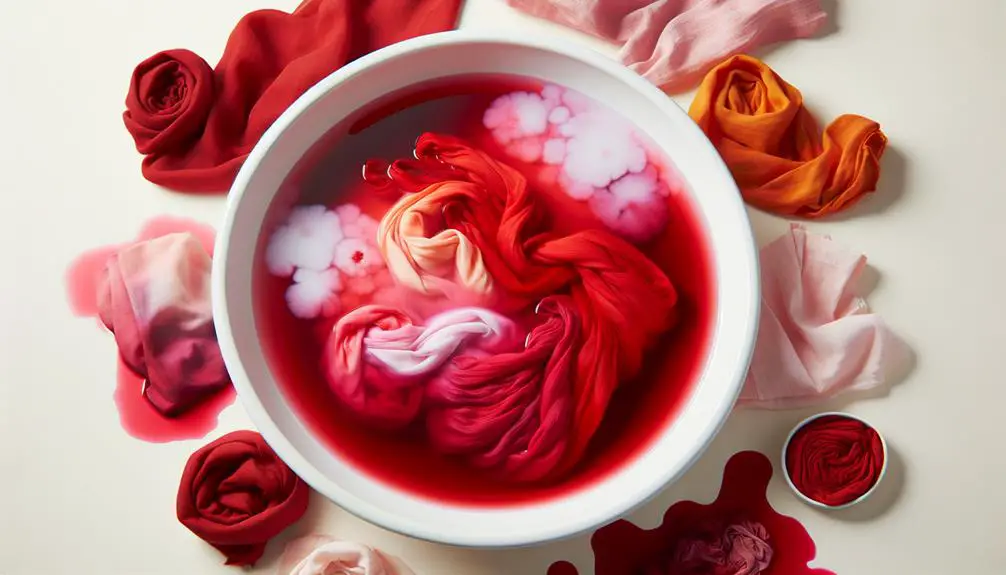Yes, I've noticed that rayon can bleed color, especially when it's not cared for correctly. This fabric is super sensitive to water and detergents due to its semi-synthetic nature derived from cellulose fibers. If you use hot water or harsh chemicals, you're setting yourself up for some serious color run. Always stick to cool or lukewarm water and mild detergents. I make it a habit to test for color fastness before doing a full wash. And trust me, sticking to the right washing methods makes a big difference in keeping those vibrant colors intact. Stick around, and you'll pick up more care tips to keep your rayon looking its best.
Table of Contents
Key Takeaways
- Rayon can bleed color when washed in hot water or with harsh detergents.
- Alcohol, perfumes, and sweat may also cause color bleeding in rayon.
- Testing for color fastness before washing can help prevent unwanted color transfer.
- Using cold water and mild detergents reduces the risk of color bleeding.
- Hand washing and avoiding harsh chemicals are recommended to maintain rayon's color integrity.
Understanding Rayon Fabric
Rayon, a semi-synthetic fabric derived from cellulose fibers, feels as soft and luxurious as silk. Although it mirrors the elegance of natural fibers, rayon requires specific care to maintain its aesthetic and functional qualities. Its origins from regenerated cellulose make it particularly sensitive to how it's handled during cleaning and everyday use.
To care for rayon effectively, I always recommend reading the care labels on garments or fabric products. This isn't just a casual suggestion—it's essential. Rayon can behave unpredictably with water and various detergents. Generally, it's safest to hand wash rayon items in cool water with a mild detergent. This method reduces the risk of damage and color bleeding, which rayon is notorious for, especially in darker shades.
Moreover, avoid wringing or twisting rayon to remove excess water. Instead, I gently press the water out and lay the fabric flat to dry. This careful handling helps maintain the integrity of the fibers and prevents misshaping. Remember, rayon isn't just another fabric; it requires a touch more consideration to keep it looking its best. With the right care, rayon remains a favorite for its silky feel and flowing appearance.
Causes of Color Bleeding
Several factors can cause rayon fabrics to bleed color, including the washing method and exposure to certain chemicals or substances. When I'm handling rayon, I've noticed that typical culprits like hot water or harsh detergents can really mess things up. These aggressive cleaning agents break down the bonds between the dyes and the cellulose fibers of rayon, leading to noticeable color bleeding. It's important to stick to cooler temperatures and milder soaps to keep those vibrant colors intact.
Moreover, everyday substances that you wouldn't normally suspect, such as alcohol, perfumes, or even your own sweat, can initiate color bleeding in rayon garments. I've learned to advise customers to be cautious with their rayon items around these materials. Spritzing perfume or a deodorant containing alcohol can be enough to start dissolving the dye, and before you know it, the color's running.
To prevent these mishaps, it's crucial to avoid using spotting agents that contain harsh chemicals like mineral acids or bleaches during any stain removal attempts. Opting for gentler alternatives and proper washing methods can significantly reduce the risk of color bleeding and help maintain the garment's original look longer.
Testing for Color Fastness
Given the propensity of rayon to bleed color, it's wise to test for color fastness before proceeding with any washing or treatment. I've learned that taking a few minutes to perform this simple test can save a lot of grief later on. Here's how I do it:
First, I find a hidden part of the garment, like an inside seam. I dampen a white cloth with water or a mild detergent solution and press it against the fabric. I hold it there for about a minute, then check the cloth for any color transfer. If I see dye on the cloth, it's a clear indicator that the garment might bleed color if washed with other items.
To make things clearer, here's a quick reference table I use to keep track of my tests:
| Test Area | Result |
|---|---|
| Inside seam | Color transfers |
| Underneath label | No color transfer |
| Inside hem | Color transfers |
| Inner cuff | No color transfer |
| Side seam | Color transfers |
This table helps me decide how to handle washing the garment. Testing for color fastness is a crucial step if you want to preserve the vibrant colors of your rayon clothes.
Washing Rayon Properly
When it comes to washing rayon properly, picking the right detergent is crucial. You'll want to avoid harsh chemicals that can cause the colors to bleed.
It's also important to use the correct water temperature; cool to lukewarm water is best to minimize any risk of bleeding.
Choosing the Right Detergent
To prevent color bleeding in rayon, it's crucial to choose a mild detergent designed for delicate fabrics. Using the right detergent not only keeps the colors vibrant but also maintains the fabric's integrity. Here's a quick guide to help you pick the best detergent for your rayon garments:
| Detergent Type | Fabric Suitability | Color Safety |
|---|---|---|
| Mild Detergent | Best for Rayon | High |
| Regular Detergent | Not recommended | Low |
| Bleach | Avoid for Rayon | Very Low |
Always check the label on your rayon garments for specific washing instructions. Opting for a gentle, color-safe detergent minimizes the risk of unwanted color bleeding. So, stick with something mild!
Correct Water Temperature
Washing rayon in cold water is essential to prevent color bleeding and maintain its vibrant appearance. You'll find that using hot water can be a quick way to ruin the fabric's look, as it tends to make rayon bleed color. This is why it's a good practice to always check the care label for specific water temperature guidelines. Adhering strictly to these instructions ensures that your rayon garments stay looking as good as new.
Also, be cautious about mixing rayon with other items in the wash that are known to bleed color. This can prevent unwanted stains and further preserve the integrity of your rayon clothing. So, always remember, cold water is your best friend when washing rayon!
Drying and Ironing Tips
Now that we've talked about how to wash rayon, let's move on to how you should dry and iron it to keep it looking its best. I'll cover the best techniques to dry rayon without causing color bleed or damage, and I'll give you some tips on how to iron it safely so you don't end up scorching the fabric.
We'll also look at how to avoid heat damage during these processes, ensuring your rayon garments stay vibrant and smooth.
Optimal Drying Techniques
Let's explore some effective drying techniques for rayon to maintain its vibrant color and avoid damage. After washing, it's crucial to use a drying rack rather than a tumble dryer, which can be too harsh on rayon fibers. For extra care, lay the garment on a clean cotton towel, roll it up to absorb excess moisture, then unroll and lay flat to dry on the rack. This method minimizes the chances of color bleeding.
| Technique | Benefit | Emotion Evoked |
|---|---|---|
| Use drying rack | Preserves fabric | Relief |
| Cotton towel | Gentle drying | Trust |
| Flat drying | Reduces wrinkles | Satisfaction |
| Avoid tumble dry | Prevents shrinkage | Security |
| Slow drying | Enhances longevity | Contentment |
Ironing Rayon Safely
Ironing rayon safely requires a gentle touch and careful heat management to keep your clothes looking their best. When I iron rayon, I'm always cautious to use low heat to avoid any damage. Here's how I do it:
- Turn it Inside Out: Always flip your rayon garments inside out. This prevents the outer surface from getting that unwanted shiny appearance.
- Skip the Steam: I avoid using steam as it can weaken rayon fibers. Keeping it dry ensures the fabric stays intact.
- Use a Barrier: A clean hand towel between the iron and the fabric works wonders. It protects the rayon from direct heat and helps distribute it evenly.
These steps help me maintain my rayon items in top-notch condition.
Preventing Heat Damage
Continuing with our care for rayon, it's also vital to manage how we dry these garments to prevent any heat-related color bleeding. Rayon fabrics are particularly sensitive to high heat, which can cause the dye to release and bleed. To avoid this, I always use low heat settings on my dryer.
It's essential to remove excess water gently before drying—never wring out rayon as it can damage the fibers. Instead, I lay the garment flat on a towel and roll it up to press out the water.
When it comes to ironing, I stick to a low heat setting and always use a pressing cloth to protect the fabric's surface. This careful approach helps maintain the vibrant color of my rayon garments.
Preventing Future Bleeding
To prevent future color bleeding in rayon, always wash these items separately or with similar colors. I've found that handling rayon with extra care can significantly reduce the risk of ruining your favorite garments with unwanted streaks or blends of colors. Here's a straightforward approach to managing your rayon wardrobe:
- Use Cold Water: Always opt for cold water when washing rayon. This helps maintain the integrity of the fabric's color and prevents the dye from loosening and spreading.
- Mild Detergent: Skip any harsh chemicals and choose a mild detergent. Harsh cleaning agents can be too aggressive for rayon, increasing the likelihood of color bleeding.
- Hand Washing: Whenever possible, hand wash your rayon garments. This gentle method greatly minimizes the stress on the fabric, which in turn reduces the risk of color bleeding. It allows you to control the handling and the amount of detergent used, making it easier to preserve the fabric's original look and feel.
Following these tips, I've managed to keep my rayon clothes vibrant and fresh-looking without the distressing effects of color bleeding. It's all about the right technique and a bit of patience!
Choosing the Right Detergent
Selecting the right detergent is crucial for keeping rayon fabrics from bleeding color. When you're dealing with delicate rayon garments, the choice becomes even more critical. I've found that a pH-neutral detergent is your best bet to prevent unwanted color runs. These detergents are gentle and designed to maintain the integrity and brightness of your fabrics without harsh chemicals.
You'll also want to steer clear of detergents that contain bleach or brighteners. These can be too harsh for rayon, leading to color loss rather than preservation. Instead, opt for color-safe detergents that are formulated specifically for delicate materials. This way, you're not only cleaning your garment but also ensuring it remains vibrant after each wash.
For those who prefer hand washing, consider detergents made specifically for this purpose. They're often milder and perfect for handling sensitive rayon pieces. Here's a quick guide to help you pick the right detergent:
| Detergent Type | Recommended for Rayon? |
|---|---|
| pH-neutral | Yes |
| With bleach | No |
| Color-safe | Yes |
| For hand wash | Yes |
| With brighteners | No |
Choosing wisely can significantly extend the life and appearance of your rayon fabrics.
Handling Stains on Rayon
When it comes to handling stains on rayon, spot cleaning techniques are your best bet.
You've got to be careful though, as preventing color transfer is crucial to maintaining the garment's look.
Always test your cleaning solution on a small, hidden part of the fabric first to avoid any heartache.
Spot Cleaning Techniques
Handling stains on rayon requires careful selection of cleaning agents to avoid color bleeding. When I'm tackling stains on rayon, I always skip any cleaners containing alcohol, mineral acids, or bleaches. These can be harsh and often lead to unwanted color loss. Instead, I opt for gentler options and make sure to test them on a less visible part of the garment first.
Here's how I handle spot cleaning techniques for rayon:
- Test First: Always dab a bit of the cleaner on a hidden area to check for colorfastness.
- Gentle Application: Apply the cleaner softly using a clean cloth to avoid stressing the fabric.
- Cold Rinse: After treatment, rinse the area thoroughly with cold water to remove any residue.
Preventing Color Transfer
After discussing spot cleaning techniques, let's focus on how to prevent color transfer while managing stains on rayon. We know rayon's notorious for color bleeding, especially when mishandled during a cleanup of spills. Here's the catch: don't use spotting agents that can harshly affect the fabric. Instead, here's what I recommend:
| Avoid | Why? |
|---|---|
| Alcohol based cleaners | Increases risk of color bleeding |
| Mineral acids & bleach | Can severely damage and fade colors |
| Ignoring test spots | May lead to widespread color transfer |
Always test stain removers on a hidden area first to ensure they won't exacerbate the problem. It's better to be safe than sorry when you're dealing with delicate fabrics like rayon.
Storing Rayon Garments
To keep your rayon garments in top condition, store them in a cool, dry place away from direct sunlight. This simple step is crucial in the care for rayon, helping to maintain the vibrant colors and integrity of the fabric. When you're planning how to store rayon garments, consider not just the location but also the method to ensure they last longer and stay beautiful.
Here's how I manage my rayon items to prevent damage:
- Hang on Padded Hangers: To keep the shape intact and avoid any creases or color bleeding, I always use padded hangers. They're gentle on the fabric and help retain the garment's form.
- Avoid Long-Term Folding: Instead of folding rayon garments, which can lead to creases and color transfer, hanging them is the safer choice. If I must fold them due to space constraints, I make sure it's for a short duration.
- Use Mothballs or Cedar Blocks: I place these in my closet to deter pests. Mothballs and cedar blocks protect the rayon without harming the fabric's quality.
Professional Care Options
While I usually hang my rayon garments to preserve their shape and color, I sometimes rely on professional dry cleaning to ensure they remain vibrant and intact. Given rayon's base in cellulose fibers, it's prone to mishaps like color bleeding when not treated carefully. That's where professional care really shines.
Professional dry cleaners specialize in handling delicate materials such as rayon. They use cleaning agents that are far gentler than what I could typically use at home. These specialized techniques protect the fabric's integrity and prevent the dreaded color bleed. It's comforting to know that the expertise at these establishments extends to a deep understanding of how cellulose fibers react with various chemicals and detergents.
Opting for dry cleaning might seem a bit over the top for some, but for those of us looking to maintain our rayon items in top-notch condition, it's a worthwhile investment. The professionals ensure that the original color and appearance of our garments don't fade away with each wash. This kind of care keeps my favorite pieces looking as striking as the day I bought them, without the risk of damaging these sensitive fibers.
Frequently Asked Questions
Does Rayon Bleed When Washed?
Yes, I've found that rayon does bleed when washed. It's crucial to wash it in cold water and separate from other clothes to avoid staining. Always check the label for specific care instructions.
Does Rayon Leave Colour?
Yes, I've noticed that rayon can leave color, especially when wet. It's crucial to handle it gently and follow specific care instructions to avoid any color transfer to other fabrics.
Can You Wash 100% Rayon?
Yes, you can wash 100% rayon, but it's tricky. I always hand wash mine gently in cold water and avoid wringing it out to maintain its quality and prevent any potential damage.
Does Rayon Color Fade?
Yes, rayon color can fade over time. It's sensitive to sunlight and frequent washing. To minimize fading, I wash my rayon garments gently and avoid harsh chemicals or prolonged exposure to light.
- How Does Ring Spun Cotton Affect Garment Fit and Shape Retention? - August 13, 2024
- What Are the Challenges in Producing Ring Spun Cotton? - August 13, 2024
- Is Ring Spun Cotton Suitable for Plus-Size Clothing? - August 13, 2024







